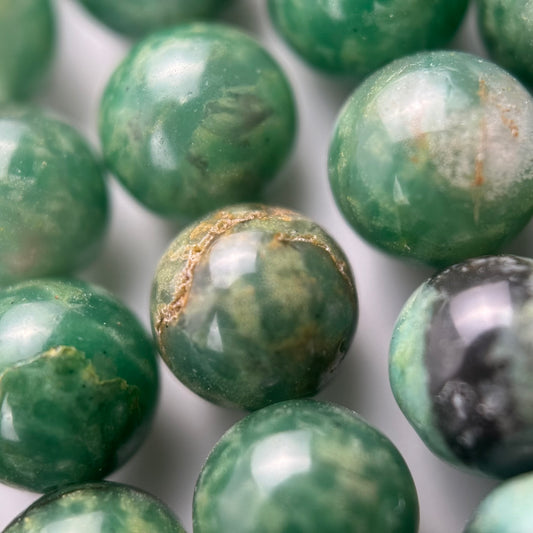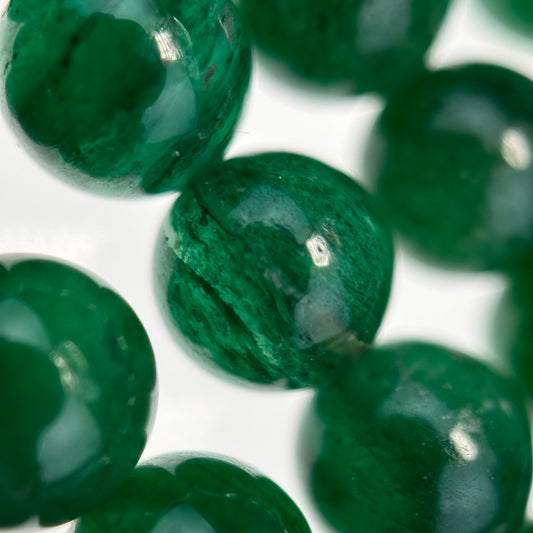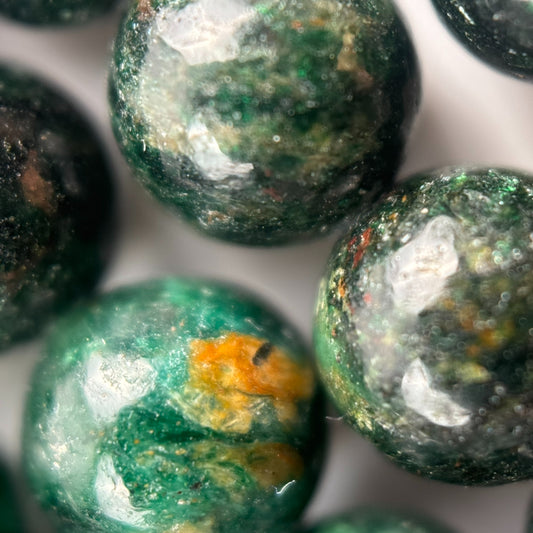Fuchsite Gemstone Beads
What Is Fuchsite?
Fuchsite is a green variety of muscovite mica, distinguished by the presence of chromium, which gives it its characteristic emerald to light green color. It belongs to the phyllosilicate group and is often found in metamorphic rocks, especially schists.
Due to its sparkling surface and vibrant hue, fuchsite is both scientifically interesting and aesthetically appealing. It's commonly used in lapidary work and metaphysical practices, making it a popular choice among collectors and jewelry makers.
Fuchsite Crystal Overview
Fuchsite crystals usually form in thin, platy layers with a pearly to vitreous luster. These crystals are often found intergrown with quartz or as inclusions in other minerals, giving them a layered appearance with a shimmering effect.
It is not a standalone mineral species but rather a chromium-rich variant of muscovite. Its structural and optical properties reflect its place in the mica family, exhibiting perfect basal cleavage and a Mohs hardness of about 2–3.
Fuchsite Beads for Jewelry Making
Fuchsite beads are prized for their glittering texture and rich green hues, making them ideal for bracelets, necklaces, and other types of artisan jewelry. The reflective mica surface adds a natural shimmer that enhances the aesthetic value of each piece.
Due to its relative softness, fuchsite beads are often stabilized or backed with quartz to improve durability. Handpicked and polished, these beads are popular among designers looking to add a natural and earthy touch to their creations.
Fuchsite Color and Appearance
The color of fuchsite ranges from pale green to deep emerald, primarily due to the presence of chromium in its chemical structure. The mineral’s surface often displays a sparkling sheen, a result of its layered crystal structure.
In its raw form, fuchsite can look flaky or fibrous, while polished specimens reveal a vibrant, glassy luster. The visual appeal makes it a favorite among both collectors and crystal healers.
Fuchsite Meaning, Benefits, and Healing Properties
In metaphysical circles, fuchsite is regarded as a stone of rejuvenation and heart-centered energy. It is believed to help in emotional recovery and to promote a sense of compassion and resilience.
Practitioners often use fuchsite to balance the heart chakra and support physical healing, especially for ailments related to stress or fatigue. While these properties aren't scientifically proven, they contribute to the stone’s popularity in spiritual and holistic communities.
Is There Such a Thing as Ruby Fuchsite?
Yes, ruby fuchsite is a natural combination of red corundum (ruby) and green chromium-rich fuchsite. This unique mineral pairing is not only visually striking but also geologically fascinating, as it results from specific pressure and temperature conditions during metamorphism.
Ruby fuchsite is widely used in jewelry and metaphysical practices due to its vivid contrast of red and green hues. The stone symbolizes vitality, courage, and heart-centered growth, combining the energies of both ruby and fuchsite.
The Mineral Composition of Fuchsite
Fuchsite is a chromium-bearing variety of muscovite, a potassium aluminum silicate belonging to the mica group. Its chemical formula is K(Al,Cr)2(AlSi3O10)(OH)2, where chromium partially replaces aluminum in the crystal structure.
The presence of chromium is critical not only to its color but also to some of its minor chemical and optical variations. These compositional details make fuchsite a subject of interest for mineralogists and geologists alike.
How Fuchsite Forms in Nature
Fuchsite forms in metamorphic environments, particularly within schists and phyllites that have undergone regional metamorphism. The chromium necessary for its formation is typically sourced from surrounding ultramafic rocks.
Its development is closely tied to the alteration of other mica minerals in the presence of chromium, making its occurrence somewhat limited to specific geological conditions.
Fuchsite as a Chromium-Rich Variety of Muscovite
Fuchsite is essentially muscovite that has undergone chromium substitution, which significantly alters its appearance and properties. Unlike standard muscovite, fuchsite’s green coloration and higher chromium content distinguish it within the mica group.
This substitution affects not only its color but also its trace element content, making it identifiable through both visual inspection and mineralogical testing techniques such as X-ray diffraction and electron microprobe analysis.
Physical and Optical Properties of Fuchsite
Fuchsite displays a pearly to vitreous luster and has perfect cleavage on one plane due to its layered mica structure. Its hardness is relatively low, ranking about 2–3 on the Mohs scale, which makes it soft but flexible.
Optically, fuchsite is translucent in thin sheets and exhibits pleochroism, where the green shade varies slightly when viewed from different angles. It also has a specific gravity of around 2.8–2.9.
Geological Locations Where Fuchsite Is Found
Fuchsite is found in metamorphic rock formations in several parts of the world. Major deposits are located in Brazil, India, Russia, and the United States. These regions provide the specific pressure and chromium-rich conditions needed for its formation.
In some locales, fuchsite is found alongside quartz and corundum, forming the popular ruby fuchsite combination. Its presence often indicates regional metamorphism and the transformation of chromium-rich rocks.
Fuchsite vs. Other Mica Minerals: A Scientific Comparison
Compared to other mica minerals like muscovite and biotite, fuchsite stands out due to its chromium content and green coloration. While muscovite is usually colorless to silvery, and biotite is typically black or brown, fuchsite's vivid green is unique.
Structurally, fuchsite shares the same sheet silicate framework as its relatives, but its chemical composition gives it different physical and optical properties. It also reacts differently under polarized light and mineral testing tools.
The Role of Chromium in Fuchsite’s Green Color
Chromium is the key element responsible for the green color of fuchsite. When chromium atoms substitute for aluminum in the muscovite crystal lattice, they alter the way light interacts with the mineral’s surface, resulting in its vibrant hue.
The intensity of the green depends on the concentration of chromium. This makes chromium not only a colorant but also a diagnostic element when identifying fuchsite in a geological setting.
Crystal Structure and Hardness of Fuchsite
Fuchsite, like all mica minerals, has a layered or phyllosilicate structure, with sheets of silicate tetrahedra bonded together by interlayer cations. This structure is responsible for its perfect basal cleavage and its ability to flake easily.
Its hardness of 2–3 on the Mohs scale makes it relatively soft, so it is typically used in low-impact decorative applications. Despite its fragility, the structure provides flexibility and a natural shimmer when light hits the flat planes.
Frequently Asked Questions
What is the origin of the name Fuchsite?
Fuchsite is named after the German mineralogist Johann Nepomuk von Fuchs. The name honors his contributions to mineralogy and chemistry in the 19th century.
Is Fuchsite a type of mica?
Yes, Fuchsite is a chromium-rich variety of muscovite, which belongs to the mica mineral group. It shares the same sheet silicate structure as other micas.
What gives Fuchsite its green color?
The green color of Fuchsite comes from chromium ions substituting for aluminum in its crystal structure. The more chromium present, the more vivid the green.
What is the difference between Fuchsite and Muscovite?
Fuchsite is a chromium-bearing variant of muscovite, while standard muscovite is colorless to silvery. The two share structural similarities but differ in color and trace element content.
Where is Fuchsite commonly found?
Major deposits of Fuchsite are located in Brazil, India, Russia, and the United States. It typically forms in metamorphic rocks like schist and phyllite.
What is Ruby Fuchsite?
Ruby Fuchsite is a naturally occurring mineral combination of red corundum (ruby) embedded in green fuchsite. This contrast makes it highly popular in both metaphysical and jewelry applications.
Is Fuchsite a rare mineral?
Fuchsite is not considered rare, but high-quality specimens with intense color and shine are less common. Its availability varies based on geographic and geological conditions.
Can Fuchsite be used in jewelry?
Yes, but due to its softness (Mohs 2–3), Fuchsite is usually stabilized or combined with quartz to make it more durable for use in beads, pendants, and other jewelry pieces.
How hard is Fuchsite?
Fuchsite has a Mohs hardness of 2 to 3, making it relatively soft and prone to flaking. It must be handled carefully to prevent damage during cutting or wear.
What are the metaphysical properties of Fuchsite?
Fuchsite is believed to promote emotional healing, renewal, and a stronger connection to the heart chakra. It is often associated with stress relief and compassionate thinking.
Can Fuchsite be combined with other crystals?
Yes, Fuchsite pairs well with quartz, ruby, aventurine, and lepidolite. These combinations can enhance both the visual and energetic appeal of crystal grids or jewelry.
How do you clean and care for Fuchsite?
Clean Fuchsite gently using lukewarm water and a soft cloth. Avoid harsh chemicals or ultrasonic cleaners, as the mineral is soft and can be damaged easily.
How does Fuchsite form in nature?
Fuchsite forms during regional metamorphism, where existing mica minerals are altered in the presence of chromium-rich fluids under high pressure and temperature.
Is Fuchsite magnetic or conductive?
No, Fuchsite is neither magnetic nor electrically conductive. Its properties are similar to other silicate minerals, being mostly inert in terms of magnetism and conductivity.
How can Fuchsite be identified?
Fuchsite is identified by its green color, pearly luster, and flaky texture. It can be confirmed through tests such as X-ray diffraction and chemical analysis to verify chromium content.
Does Fuchsite fluoresce under UV light?
No, Fuchsite typically does not fluoresce. Its optical properties are more related to its reflective surface and layered crystal structure.
What chakra is Fuchsite associated with?
Fuchsite is commonly associated with the heart chakra, believed to encourage emotional balance, forgiveness, and self-worth in spiritual practices.
What is the spiritual significance of Ruby in Fuchsite?
Ruby in Fuchsite is thought to combine the heart energy of fuchsite with the passion and courage of ruby, creating a powerful stone for emotional and spiritual growth.
Is Fuchsite the same as Green Aventurine?
No, although both are green and often confused, Green Aventurine is a quartz variety with mica inclusions, while Fuchsite is a chromium-rich mica mineral itself.
Can Fuchsite be faceted like gemstones?
Due to its softness and cleavage, Fuchsite is rarely faceted. It is more commonly shaped into cabochons, beads, or left in raw form for display or metaphysical use.





